
Record Pressing Services Used By Capitol Records of Canada
Developed by Piers A. Hemmingsen
Compo history segment by Edward B. Moogk
RCA Victor Studios, Toronto, Ontario
RCA Victor in Toronto was the company that Capitol of Canada used in the 1960s and 1970s to create the pressing masters when none were provided by Capitol USA or when one of the USA metal parts wore out. Mr. Fred Burchill and Mr. Graham Newton were the two RCA Toronto engineers who manned RCA’s Scully lathe at the 225 Mutual Street office between1963 and 1965 to create the masters for the Canadian Capitol Beatles LPs from the first LP Beatlemania through to Beatles 65.
Graham Newton’s initials (GN) often appear in the run out area of these mid 1960s LPs as well as on Canadian Capitol 45s like Ticket To Ride / Yes It Is (Capitol 5407).
Much of the information obtained in this area originated from conversations with Bruce Spizer in New Orleans and then through initial contact and a subsequent meeting with Graham Newton (October 31, 1999).
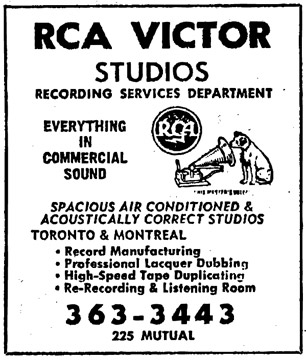
RCA advert in Bell Canada Yellow Pages for the City Of Toronto
(1966)
Graham Newton, cutting masters at RCA
Graham Newton worked in the record division of RCA in Toronto for about two years beginning 1964 and cut most of the monaural master phonograph records for Canadian distribution, both of RCA releases and for other companies for which RCA did the manufacturing (including Capitol of Canada and their Beatles records). During this time RCA’s record pressing plant was located in Smiths Falls, Ontario where they also did the pressings for Capitol, Kapp, Phonodisc, etc. During his time with RCA, Graham did both LP and 45 rpm mastering, but the larger part of his work on Capitol product was for their 45 rpm releases and these were all monaural recordings.
Graham recalls that in the 1960s, it was common for RCA to receive regular release pressings from Capitol USA or EMI in the UK, for use as source material for Canadian 45 releases. Capitol mostly used the services of RCA Toronto to cut the lacquer masters for their Canadian releases. The studios were located in those days, at 225 Mutual Street in downtown Toronto, south of Carlton, just west of Jarvis St.
These «foreign» release discs were then directly transferred to a lacquer master that was used to make new 3 step (matrix, mother and stampers) metal parts for pressing purposes. The lacquer master would then be sent to RCA’s pressing plant in Smiths Fall where the new metal parts would be made for stamping out the release discs.
Graham states that the lacquer masters for monaural discs were cut at RCA using a Scully lathe with a Westrex cutter head, and that the stereophonic masters were done on a Neumann lathe with the then-new Westrex 3B cutting head. All very technical !
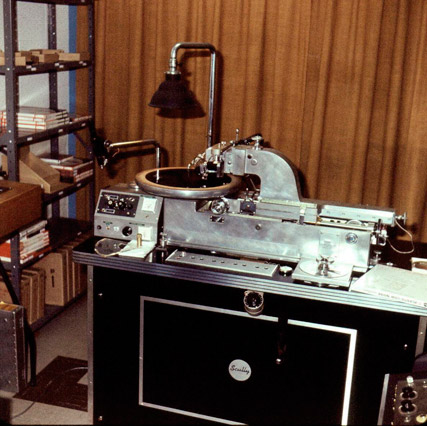
Photo of the RCA Mutual Street Scully lathe set up (courtesy Graham Newton,
RCA Victor employee, Toronto, 1964-1966) /PAH - 31 October 1999
pressing the records
Where Capitol of Canada received the metal parts directly from the USA, the corresponding records would be pressed from stampers made from the USA supplied mothers by RCA’s Smith Falls plant. Most of the 72000 releases have handwritten matrix numbers scribed into the run-out area and these were the releases that were done by RCA’s mastering services in Canada. The handwritten matrix numbers were written by the person cutting the master lacquer. At RCA in Toronto, Graham Newton and another engineer named Fred Burchill (now deceased) hand-wrote the matrix numbers on lacquer masters cut by them, latterly adding their initials at the three o’clock position on their specific work.
In those days, records were purchased by teens and were treated as very disposable items that would be played often for a few weeks or months until they were replaced by new favourites from a new top ten. Teens were not an affluent lot and, with technology being relatively crude then, it meant that most 45s were often played on very inexpensive portable record players purchased for $29.95 or less from stores like Eatons or Simpsons.
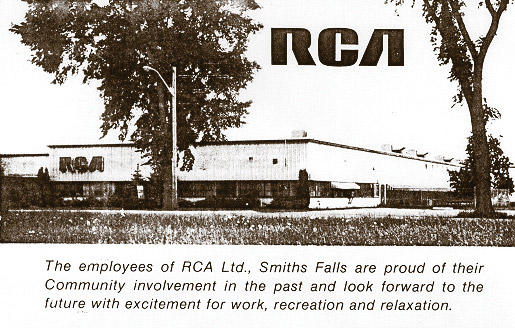
RCA Simth Falls, Ontario pressing plant. 1968.
To test the viability of these records aimed at the teen market, Graham and Fred would test their handiwork on what they referred to as a «TRUTH BOX» which in reality was nothing more than one of the previously mentioned $29.95 record players! Graham put my original copy of the stereo Beatles Help LP under a groove microscope to show that the bass had been minimized so that the record’s groove swings would not cause the needle to skip when played on a teens «cheap» record player! Because most of the early Beatles Canadian Capitol 45s were cut using either master tapes or release copies of 45s mailed to Canada directly from England, there is a good chance that Graham Newton or Fred Burchill cut these masters which were then pressed by RCA in Smiths Falls.
Compo Records – Lachine, Québec and Cornwall, Ontario
Compo Company Ltd. First Canadian independent record pressing plant; also the largest of its day. Established in 1918 as a pressing plant at Lachine, near Montreal, by Herbert S. Berliner (then vice-president and general manager of the Berliner Gram-O-Phone Co), it initially handled US labels such as Phonola (record label) and Starr-Gennett (record label). Berliner resigned from the Berliner Gram-O-Phone Co in April 1921, taking many of that company's senior staff to Compo; the two companies became bitter rivals as a result.
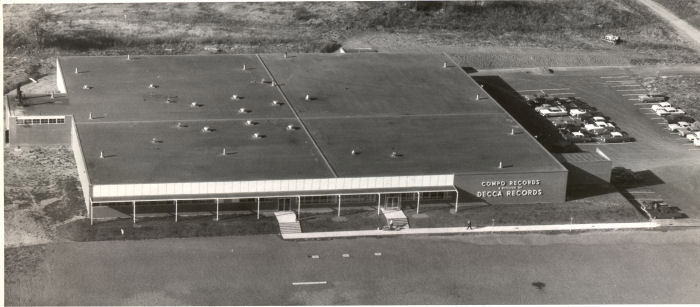
Compo Cornwall, Ontario pressing plant.
Compo's first house label, Sun, based in Toronto, was introduced in May 1921. It was supplanted in September by Apex, a name which continued in use for over 50 years, passing through the control of several companies. Other labels were adopted (at one time Compo had over 20), among them Domino (record label), Microphone (record label), Sterling (record label), and Lucky Strike (record label). In 1924 Apex phonographs were introduced. As Herbert Berliner had a great personal interest in radio and its ramifications, Compo was the first Canadian company to issue microphone recordings (in 1924) and records taken from radio broadcasts (in 1925). It was one of only two recording companies in Canada to survive the depression of the 1930s, diversifying its activities to include the manufacture of cylinder records (for dictation machines) and radio transcriptions.
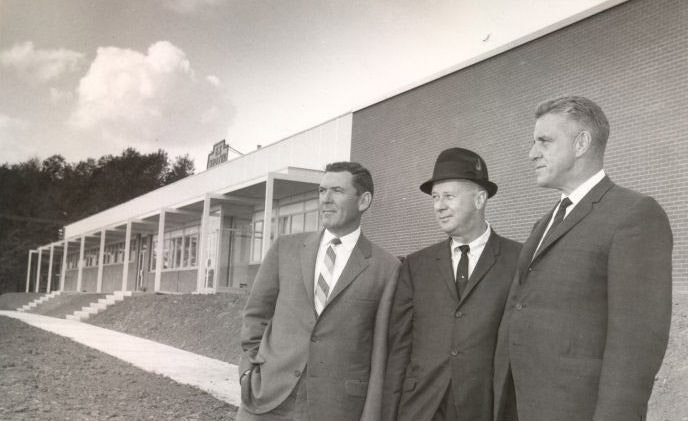
Compo Cornwall, Ontario pressing plant.
In 1935 Compo became the Canadian licensee for pressing and distributing the US Decca line. In 1951 Decca purchased Compo, retaining Berliner as its president until his death in 1966. Decca in turn was purchased in 1964 by MCA, which, besides maintaining the Lachine pressing plant until the early 1970s, established a plant in Cornwall, Ontario, which operated until 1976. The Compo and Apex labels were in use until 1971.
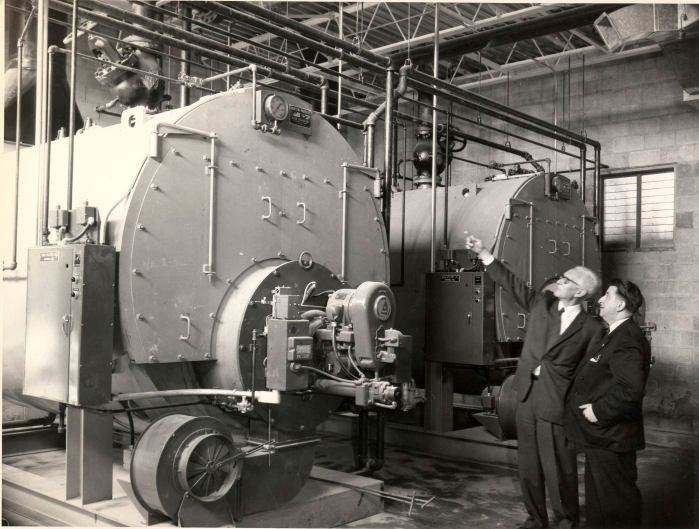
These are the two large storage units for the liquids used in the creation of the vinyl records.
Compo always recorded Canadian performers, mostly from the pop field, though in the 1920s such concert performers as Rex Battle, J.-B. Dubois, Paul Dufault, Ruthven H. McDonald, and Rodolphe Plamondon were on its roster. In addition to the performers on Compo's Starr line (the name taken over from Starr-Gennett in 1930), Compo also recorded, for Apex, the Adanac Quartet(te), Willie Eckstein, Vera Guilaroff, Al and Bob Harvey, Léo Le Sieur, the accordionist Joseph Latour, Don Messer and His Islanders, the pianist Billy Munro, the fiddler Sid Plamondor and his Western Pals, Wellie Ringuette, and the Andy Tipaldi Orchestra. Compo distributed in Canada many records made by expatriate Canadians for Decca. A number of Compo's production ledgers and masters have been deposited at the National Library of Canada.
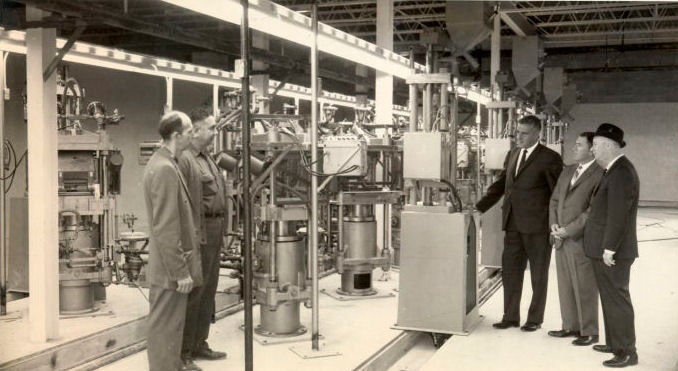
Some of the new record pressing equipment circa 1964.
first Beatles pressings
After showing Graham original vinyl copies of the first three Beatles LPs released on the 6000 series in Canada, his assessment of the handwritten matrix numbers is as follows:
T-6054 The Beatles Twist And Shout (MONO only) - mastered by Fred from UK EMI (not US) tape maste
T-6063 The Beatles Long Tall Sally (MONO only) - mastered by Graham from UK EMI* (not US) tape masters
(Graham noted that his original XEX number had been scratched out by someone else to add a different matrix number for a later release using the same original metal parts.) (* in May 2000, EMI Music Canada allowed me to have a look at the master tape for T-6063 which was held in their tape library in Mississauga, Ontario. The tape box and tape (both Emitex) originated from EMI’s parent company in England and was dated February 1964)
All three of these Beatles LPs were pressed in Canada from lacquers made by RCA in Toronto and feature a large circular groove in the label caused by the «gripper» in RCA’s pressing equipment/manufacturing process. Later Beatles LPs (like Help, Rubber Soul, etc.) as well as most 45s after I Want To Hold Your Hand were pressed in Canada using metal parts sent directly from the USA and were not pressed by RCA. As an example, the Help LP was pressed by Compo in Montreal using a metal mother sent from the US (probably created by a Scully lathe at Capitol’s US mastering facility). Compo (Lachine/Montreal) pressings featured a smaller circular indentation around the spindle hole.
Note that The Rolling Stones recorded for London Records in the USA and Canada and that their Canadian discs were pressed in London, Ontario by Sparton of Canada Limited (who had earlier pressed Capitol Records prior to the sale of Capitol Records in North America to EMI in 1958).
My «no brackets» version of the Beatlemania LP was, according to Graham, from the fourth lacquer made for this title, as indicated by the «-4» after the matrix number. As an example, I have come across multiple pressings of the Canadian «Swirl» Beatles 45 Love Me Do first released in Canada as Capitol 72076 in early 1963 using matrix numbers as follows:
Side 2 : 7XCE-17145 (Handwritten, hyphen included)
With a subsequent pressing using a «-5» suffix on both sides, indicating a fifth lacquer was needed to fill production requirements. This may not always be a good guide to the total pressing quantity as occasionally a stamper for one side was damaged and it is possibly to see a «-2» suffix on side one, coupled with a «-4» suffix on the other side owing to a damaged mother for side two having to be replaced. I am also aware of a «-4» and «-6» combination for Love Me Do.
I visited Graham’s studio in October 1999 and I was able to demonstrate samples of his handy-work to him! His initials (GN) appear in the run-out of 72237 (The Zephyrs «She’s Lost You» 45), of 72265 (The In Crowd Things She Says 45 from July 5, 1965), as well as on the Canadian Capitol 5407 release of the Beatles Ticket To Ride / Yes It Is coupling from April 1965.
By the end of 1965, Graham Newton had left RCA to work for CHUM Radio in Toronto as their assistant chief engineer. While there, Graham attended the press conference given by Capitol Records artists The Beatles at Maple Leaf Gardens at 6:30 PM Wednesday, August 17th, 1966 prior to their Toronto concert. Graham set up the microphones for «The Fabs» and duly made his mark on history with an incredibly good «HI-FI» quality recording of the proceedings from start to finish. Graham was allowed to ask one question of Paul McCartney towards the end of the conference regarding the «new» direction that their music was taking with Eleanor Rigby. This, of course, was on the eve of the many months of studio work on the forthcoming Sgt. Pepper LP.
As a general guide, the matrix numbers in the run-out area of the LPs and 45s released by Capitol of Canada can be used along with the sleeve printing and label perimeter print information to determine roughly when the record was pressed and by which company.
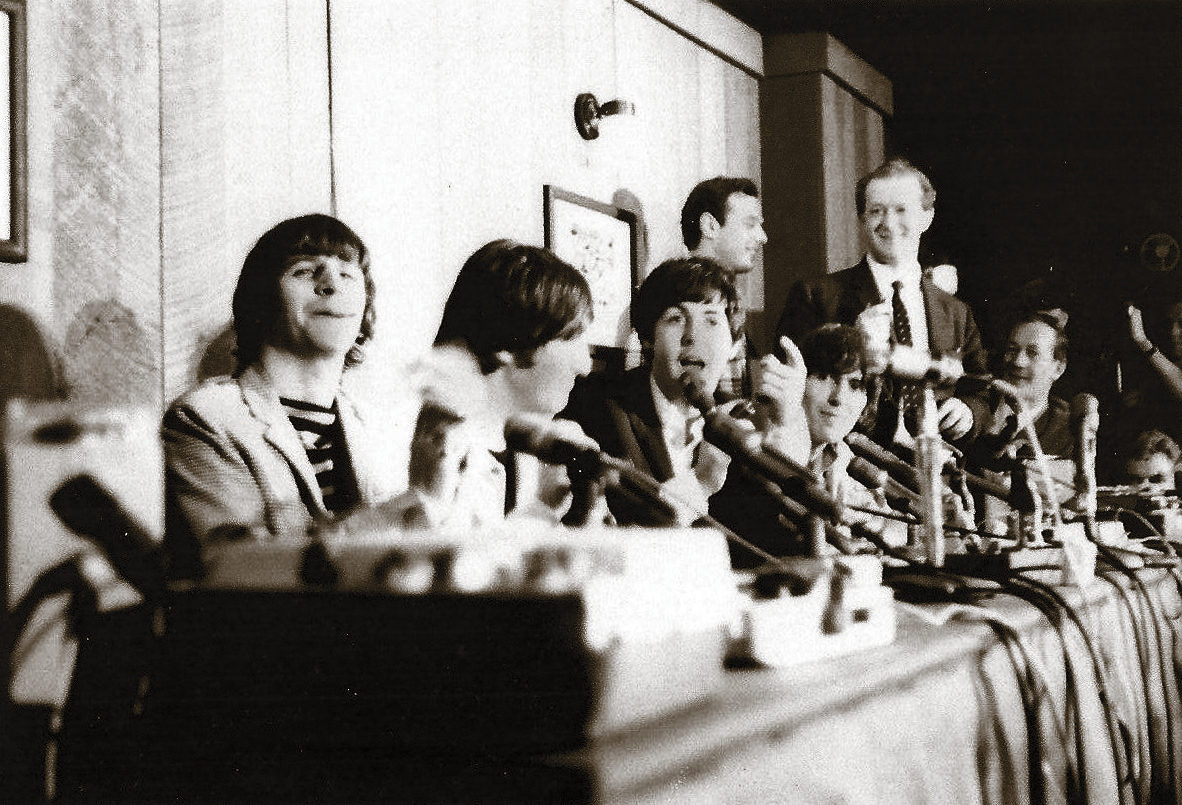
Not the 1966 conference, but the similar Toronto press conference at Hot Stove Lounge with Brian Epstein 1965, the previous year.
Copyright © 1999 - 2018
Capitol6000 & Hemmingsen Publishing
Piers A. Hemmingsen & Serge Pelletier. All Rights Reserved.